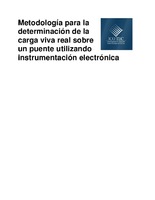Metodología para la determinación de la carga viva real sobre un puente utilizando instrumentación electrónica
Abstract
This project shows the obtained results of the real live load determination study on the Purires bridge, through the instrumentation with deformation, deflection and joint displacement sensors. This project was performed for the e-Bridge research project (Remote Bridge Failure prediction).
Static and dynamic load tests were performed by placing loaded trucks on the structure, different values of deformation, deflection and displacement were obtained with electronic instruments. Protocols for the execution of tests were defined and implemented.
Experimented load conditions were created with the software SAP 2000 in order to analyze the structure’s behavior, attempting to simulate the current bridge’s status.
The theoretical model was calibrated by utilizing an adjustment linear equation that predicts the actual forces based on the forces given by the software.
With the data obtained with the sensors, the bridge’s behavior is compared, the tension forces on the main beams, the deflections, and joint displacements are contrasted.
By the completion of the analysis it was possible to determine the structure’s capacity on the central tract, without being able to generalize to the whole bridge due to software limitations and the lack of data.
Description
Proyecto de Graduación (Licenciatura en Ingeniería en Construcción) Instituto Tecnológico de Costa Rica, Escuela de Ingeniería en Construcción, 2012.


